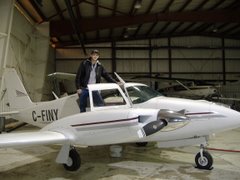Most people when they determine whether or not someone is a "good pilot" or not is usually based on how smooth their touchdown was. This is an understandable thing to base such judgements on. For most passengers, especially in an airliner setting, this is the only part of the flight that they experience first hand and the only thing they can see change from flight to flight. Everything else usually feels exactly the same. Landing is also generally known to be one of the more difficult tasks a pilot is faced with. While its true that the landing can be an excellent demonstrator of one's "stick and rudder" skills (the term used to describe one's ability to control an aircraft smoothly and accurately), I don't think it serves as a complete indicator to separate the "good" and "bad" pilots.
While it is true that it takes a great deal of skill to land an airplane, even more so in tricky conditions, such as a short field and/or gusty crosswinds, to judge a pilot soley by his landing is to sell him short of the thing that he has really spent 90% of his career trying to master. A more accurate indicator of a superior pilot comes in what is known as risk management. This is a skill far more difficult to master, far more important then superior stick and rudder skills, and far less visible to the average observer. We say risk "management" because there is always a certain degree of risk when flying. Risk ellimination would be to not go flying. Risk management is minimizing exposure to danger while still completing the flight. There are far more factors and decisions relating to risk management that a pilot must face each flight to list them exhaustively, but I'll mention a few. These decisions start before anyone even steps into the airplane.
Weather Conditions - How safe is the weather to fly in? How might it change during the flight? How do we alter our flight planning to accomodate this (wait it out, change our route, etc)?
The Airplane - Is it mechanically sound? Is anything not working properly? What do we do about it? Is the airplane's performance abilities capable of making the flight (ex. can we take off soon enough to clear those trees, are we within weight and balance limits)?
Flying - Is there any traffic presenting a hazard to us? Where is it? Is this weather presenting an unacceptable hazard to us? If we try to fly through it will be able to turn around if we can't make it? What happens if our engine quits right now? How about now? How about in 10 minutes? What if we have an instrument failure? What are our "outs"? Is the crosswind too strong for us to land on that runway? Is the runway long enough? Even if we don't make a perfect landing? What is that airplane over there doing? Is he paying attention or is he presenting a potential hazard to us?
There are alot of decisions to make relating to safety, and most of the time we have to make them on-the-fly (pardon the pun). Usually the right answers aren't always perfectly apparent. These decisions are of course entirely separate from our duties of keeping the aircraft under control. The bottom line is have we made the flight as safe as it could have possibly been? Granted good stick and rudder skills go a long way to making a flight safer, especially in tricky conditions, but good judgement can compensate for poor stick and rudder skills, whereas good stick and rudder skills can very rarely compensate for bad judgement. Risk management is something very difficult to teach. I believe it is partly a talent, partly a product of experience.
This is not to say that if the next pilot you go flying with makes a smooth touchdown not to compliment him! We still all work very hard to impress our passengers with a comfortable flight. But comfortable is not always synonimous with safe.
Subscribe to:
Post Comments (Atom)




No comments:
Post a Comment